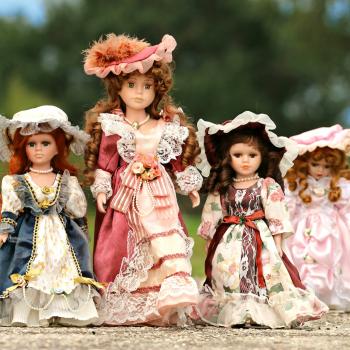Even as a big girl of four, Sally still sometimes has meltdowns. A few weeks ago, she shed loud and angry tears and created a bit of a scene in the middle of a store because I told her I would only buy her one set of princess jewelry, not the five sets she had picked out. (It may be easy to laugh at the seeming absurdity of the situation, but those five sets of princess jewelry were very important to Sally at that moment.)
Generally, Sally’s meltdowns start with simple disagreement. She wants five sets of princess jewelry, I say that she can choose one only. She argues with me, which is totally fine (because kids should be allowed to express their opinions and practice reasoning). I respond, explaining about money, and about how she can get more sets of princess jewelry another time, or maybe for her birthday. But rather than accepting my points and scaling down what she is asking for, Sally stands firm and becomes both angry and upset. And things go downhill from there.
Sally’s meltdowns don’t generally involve destructive rage. Instead, they involve loud and angry crying, and a continued insistence on having what it is she wants, a refusal to let go of the item, etc. There were a few times in the past, years ago, when Sally’s meltdowns did involve throwing things, nocking things over, and hitting whoever was in reach. We had some talks at the time about how important it is to not break things or hurt people when we are angry, and that particular feature disappeared. While Sally’s meltdowns themselves are not all that common, the loud and angry crying has remained a feature.
After this particular incident, I spoke with Sally once she had calmed down.
“Sally, I know it’s hard, but one thing you have to learn before you grow up is how to handle disappointment,” I told her. “We do not always get everything we want. I understand! It’s hard! But we have to learn how to handle those disappointments in a healthy way.”
“Well, I have not learned that yet,” Sally responded quietly.
“I know that, honey,” I said, giving her a hug. “But you’re going to be in kindergarten soon, so it’s something you need to work on. Do you have any ideas for how we might help you learn it?”
“I know!” Sally exclaimed, brightening. “How about at least one time every day you tell me ‘no’ for something that I want, and I just have to practice dealing with it.”
 I don’t think we give children enough credit. If there’s something we want kids to learn—even something like how to handle disappointment in a healthy manner—we can (and should) enlist their help in learning it. In other words, parenting needn’t be solely about something parents do to children. Parenting can and should be cooperative, involving open communication and brainstorming. And it can be like that even if they’re only four. Children have a stake in reaching adulthood as competent adults, and if you’re a kind and dependable parent, they will know that you can help them get there.
I don’t think we give children enough credit. If there’s something we want kids to learn—even something like how to handle disappointment in a healthy manner—we can (and should) enlist their help in learning it. In other words, parenting needn’t be solely about something parents do to children. Parenting can and should be cooperative, involving open communication and brainstorming. And it can be like that even if they’re only four. Children have a stake in reaching adulthood as competent adults, and if you’re a kind and dependable parent, they will know that you can help them get there.
Since that brainstorming conversation, any time I’ve run into a disagreement with Sally where I simply cannot give and she refuses to accept what I’m saying, where she is growing upset and I’m worried she is going to move toward an meltdown, I’ve reminded her of the conversation, and of her proposal.
“Sally, I’m sorry, I know this is hard, but the answer really is no,” I’ll say. “Remember what we talked about about helping you learn to handle disappointment? This is one of those times.”
“Okay,” she’ll say. And that’s it. She’ll go from upset and angry and moving towards crying to completely accepting of my “no” in a single moment. And this isn’t me forcing something on her, this all her. She accepts it.
This isn’t a get out of fuss free card for me, and it’s not about getting Sally to stop arguing and just obey. As she originally proposed it, it’s about me helping her to learn to accept being told “no” when it’s strictly necessary, when there’s no way around it—because sometimes there isn’t. And I’ll honor that intent. In fact, I think I’ve only used it a half a dozen times total. And since that day several weeks ago when she wanted five sets of princess jewelry, Sally has not had a single meltdown.
You may notice that I’ve used the term “meltdown” rather than the term “tantrum.” This is because the term tantrum has a bit of a bad rap that does not carry over to the term meltdown, even though they mean virtually the same thing. Looking around on google, I found tantrum defined as “an uncontrolled outburst of anger and frustration, typically in a young child” and meltdown defined as “a very fast loss of emotional self-control.” While the two terms mean essentially the same thing, I tend to avoid the term tantrum because of its baggage.
The bottom line is that children are not born knowing how to healthily handle their emotions and feelings. That’s something they have to learn, both through experience and through guidance. Children need to learn that it is okay for them to feel upset of disappointed, but also that they can choose how to express these feelings and do not need to let these feelings control them. Before I had children, I think I primarily thought about all the external things I would need to teach them—how to walk, how to feed themselves, how to dress themselves, how to talk, how to ride a bike—but as a parent, I have found that the internal things I must teach my children are equally important, if not more so.
And just like the external things, the internal things are something parent and child should learn together.














